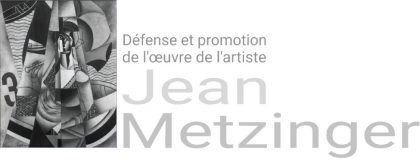Jean Metzinger Catalogue Raisonné

Number: AM-04-003 Jean Metzinger
Date: 1904
Title: Paysage
Medium: Oil on canvas
Dimensions: 53.97 x 65.08 cm
Inscriptions: Signed (lower right)
Collection: Ackland Art Museum, University of North Carolina at Chapel Hill (Accession Number: 60.26.1)
Provenance: Hirschl and Adler Galleries, Inc., New York, in 1960.
Acquired by the Ackland Art Museum in 1960.
Exhibitions: Salon de La Section d’Or, 1912 (probably), catalogue no. 123, titled Etude, 1904. Listed as collection Mme Vve Metzinger.
Selections from the Collection of Hirschl & Adler Galleries, Vol. II, Hirschl & Adler, New York, 1960, no. 75, reproduced (titled Fauve Landscape)
Musées de Bordeaux, Bordeaux, “La Peinture française, collections américaines,” 13 May – 15 September 1966, cat. 107, pl. 47. [Catalogue and Data Sheet. Ackland Art Center. Museum Collection and Loans. Catalogued by MDH, September 1, 1962.]
“Landscape in Art: Its Origin and development,” Columbia Museum of Art, Columbia, SC, 17 January – 16 February 1967, no.58.
“A Decade of Collecting,” Ackland Art Museum, 2 November – 21 December 1969, cat. No. 26.
MIMSY: Chapel Hill, Ackland Art Museum, The University of North Carolina at Chapel Hill, Painting and Sculpture from the Permanent Collection, May 15 — September 6, 1987.
Literature: Joann Moser, Daniel Robbins, Jean Metzinger in Retrospect, The University of Iowa Museum of Art, 1985, catalogue no. 2, p. 36
Notes: This landscape—which at first appears closer to Metzinger’s 1907 style—bares a date, unlike many others. There exists the possibility that it was Inscriptions: Signed and dated on the verso at a later date. If indeed this painting was realized in 1904 it would be quite significant, for the influence of Paul Cézanne is quite visible. Recall that avant-garde artists in Paris began reevaluating their work in relation to that of Cézanne primarily from 1907 onwards, following exhibits of his works at the 1906 Salon d’Automne, and especially after two commemorative retrospectives that followed his death in 1907. There was, however, a retrospective of Cézanne’s paintings that had been held at the Salon d’Automne of 1904; the year this painting by Metzinger was executed (again according to the date inscribed). Metzinger too exhibit in the 1904 Salon d’Automne, as he had in the spring of that year at the Salon des Indépendants. Metzinger’s early interest in the work of Cézanne (prior to 1907, and indeed prior to 1905), suggests a means by which Metzinger made the transformation from the Neo-Impressionism of Henri Edmond Cross and Georges Seurat (from whom his 1903 painting owe a debt) to a highly personalized form of Divisionism, evident in this work and others that led up to 1907, before the advent of Cubism. In recognizing the significance of Cézanne early on, Metzinger was already a precursor, favoring the abstract qualities of larger brushstrokes, vivid colors and the peculiarities (at the time) of non-Euclidean geometry; something increasingly visible in his painting of the following year. (Alexander Mittelmann, Jean Metzinger, Divisionism, Cubism, Neoclassicism and Post Cubism, written 2 May 2012)

